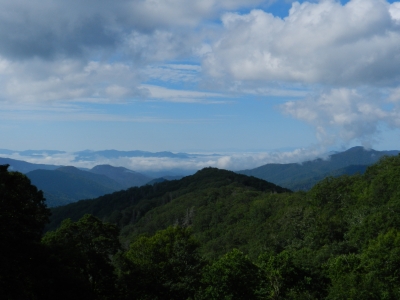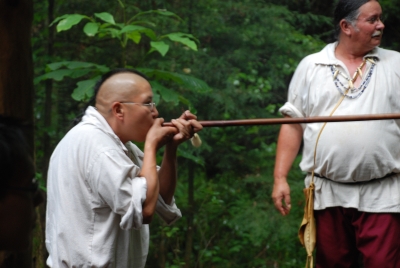More Indians
Monuments are one thing, real Cherokees quite another. In Tennessee we saw monument, in North Carolina we were going to see real Cherokees, both with feather adornments and without. The latter is the most original, but the other sare what many tourists except from indianthat's how can it goes if you are inattentive at the wrong time.
 Today's stage was very short, as we
just drove through the Great Smoky Mountains National Park from Gatlinburg to
Cherokee. Therefore we took it easy in the morning, but took the
direct route into the national park, when we finally left Gatlinburg. The first part of the
drive went fine, but when we had just crossed the border between Tennessee and
North Carolina, we ran into what we thought was road works where we got to stop for about 35 minutes. When we finally got
under way again and
passed the place, it turned out that it was actually forest workers, who
were busy pruning trees and filled the road with some very heavy machinery. As we continued,
moe than 70 cars waited in line to go the opposite
way and probably just as many were behind us.
Today's stage was very short, as we
just drove through the Great Smoky Mountains National Park from Gatlinburg to
Cherokee. Therefore we took it easy in the morning, but took the
direct route into the national park, when we finally left Gatlinburg. The first part of the
drive went fine, but when we had just crossed the border between Tennessee and
North Carolina, we ran into what we thought was road works where we got to stop for about 35 minutes. When we finally got
under way again and
passed the place, it turned out that it was actually forest workers, who
were busy pruning trees and filled the road with some very heavy machinery. As we continued,
moe than 70 cars waited in line to go the opposite
way and probably just as many were behind us.
Despite this delay, we were in Cherokee already at 11 am, far too early to get our room at the hotel we had booked from home. We therefore contnued to the neighboring town of Bryson City, where I would see another Cherokee monument. This time, the tribe's first city Kituwa, a place considered sacred by the Cherokee even today, and where the only thing that is left, is a Bronze Age burial mound. We did not locate the place though, so we continued to Robbinsville, about 20 miles further on. In Robbinsville is a small museum of Cherokee Chief Junaluska, who lived in the city in his final years - after having 'escaped' from the reservation in Oklahoma and walked back home to the tribe's original hunting grounds. Junaluska was actually called something else, that the eurpeans just could not pronounce, let alone spell ('Tsunalahunska'). He was a leader of a group of Cherokees who fought on the American side at the Battle of Horseshoe Bend in the war against the Creek tribe in 1814. During this battle he saved the American commander, Colonel, later General and even later President, Andrew Jackson's life when a Creek was about to hit him in the head with an ax. Later, when Andrew Jackson as president had adopted the law called The Indian Removal Act (1830) which forced all tribes east of the Mississippi to move to Oklahoma, Junaluskal became one of the Cherokee negotiators, but his request to let the tribe stay in the east, was rejected by the President. It was on that occasion, Junaluska said: "Had I known in 1814 what I know today, I would have acted differently back then."
We found the museum very easily, and talked a while with the lady who looked after it, an elderly Cherokee woman who told us about Junaluska as well as the tribe in general. Before we left the museum to go up to see Junaluska's grave, I asked the lady the way to Kituwa and she explained it very carefully. Then we went up on a hill and looked at the grave before we returned to Brysonville. Kituwa should be located near the road that led from Brysonville back to Cherokee, but despite the lady's careful guidance, we managed to drive past the small road leading to the site, and when we first discovered it, we didn't want to turn around, so Kituwa is yet to be visisted.
 Back in Cherokee
we got our room, so we carried our luggage up to the second floor. Then we went out to
look at the town, or rather at the Museum of
Cherokee Indians, located in town. It cost us $ 19 each to get into the museum,
and we spent about a half hour to walk around and look at the exhibits, which
was very interesting, if you are interested in Cherokee history and
culture. When we had seen whar was to be seenl, we drove up to the Oconaluftee Indian Village,
to see what time they closed. They did so at 5 pm and last entry was at 4. It was
then 3.30, and as Tim didn't want to see the place again (he did in 2000), I drove him back to the hotel
and then returned to the village myself, and just managed to get in on the last tour.
Back in Cherokee
we got our room, so we carried our luggage up to the second floor. Then we went out to
look at the town, or rather at the Museum of
Cherokee Indians, located in town. It cost us $ 19 each to get into the museum,
and we spent about a half hour to walk around and look at the exhibits, which
was very interesting, if you are interested in Cherokee history and
culture. When we had seen whar was to be seenl, we drove up to the Oconaluftee Indian Village,
to see what time they closed. They did so at 5 pm and last entry was at 4. It was
then 3.30, and as Tim didn't want to see the place again (he did in 2000), I drove him back to the hotel
and then returned to the village myself, and just managed to get in on the last tour.
Also this time it was very exciting to see and hear about Cherokees life in the middle of the 1700s, not least, I like the stories that are told in Council House on how the tribe worked in practice, with war and peace chiefs, warrior women, etc. The trivbe was matrilineśr, which means that relationship is inherited through the mother, not the father. Women were of great importance and owned all real eastate. They could divorce their husbands by just putting the husband's belongings outside the door. Among the audience was a girl, about 13-year-oldl who was there with her parents and a younger brother. She was obviously a little embarrassed to ask questions, because her mother had to do it on her behalf. She asked whether it is really true that women owned most and were the ones who decided in daily life. When this was confirmed the girl exclaimed "Super cool". I also got to hear an older man named Standing Water talk about tribal ceremonies, not least their dances. This we didn't experience the first time we visited the village in 2000.
After the visit, I drove back to the
hotel where I "found" Tim. We went out to eat at a nearby local restaurant, and
when we had eaten, we went out and walked around a little more of the town, and bought
some more gifts in some of the ubiquitous souvenir shops. Cherokee is clearly a
city that lives on tourism - and of their casino.
-
Return to Cross Country Tour -
- Return to
Travel stories -